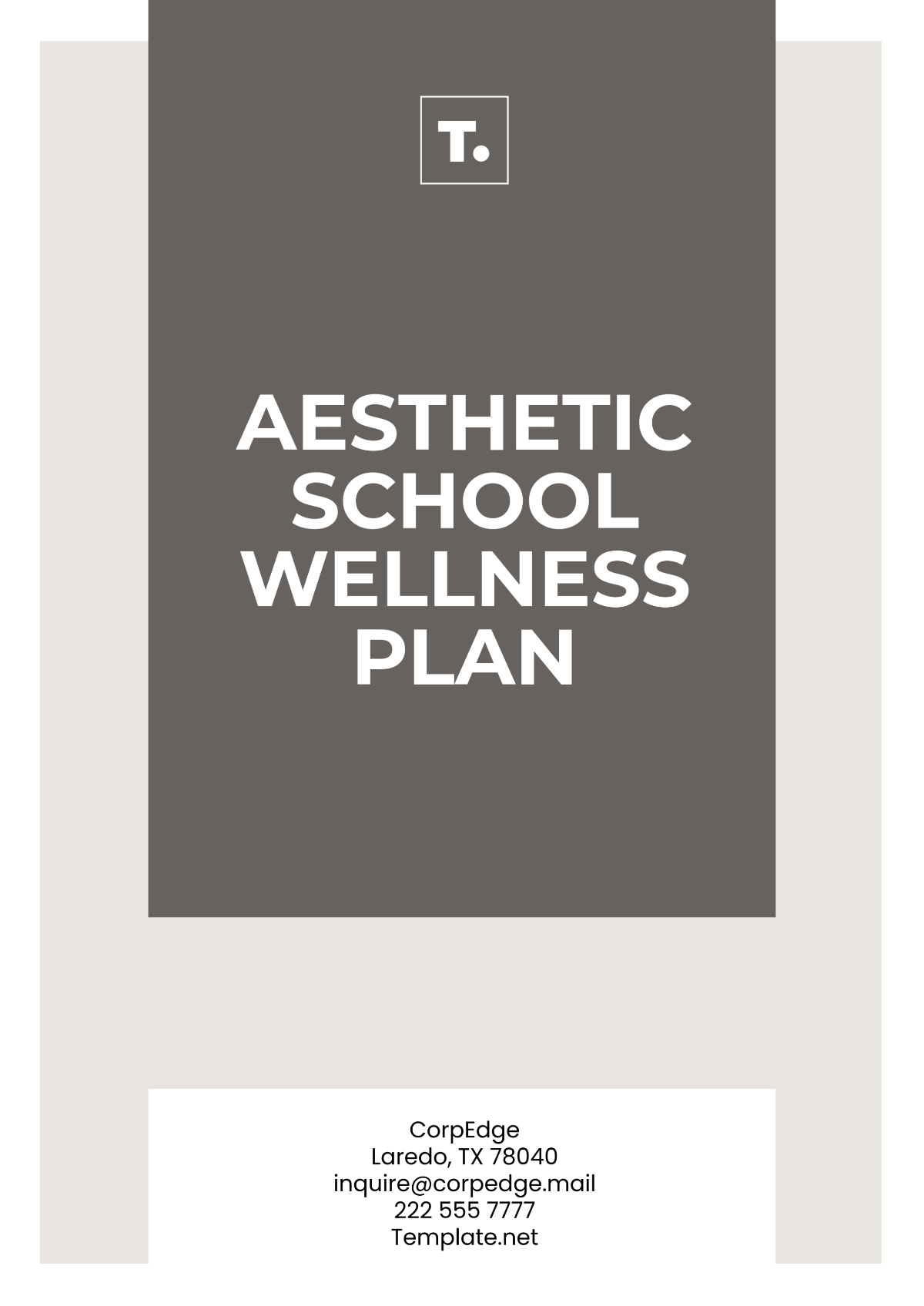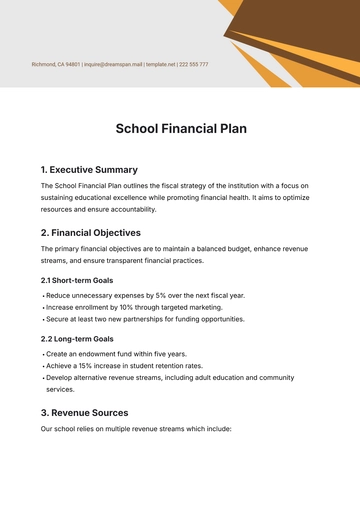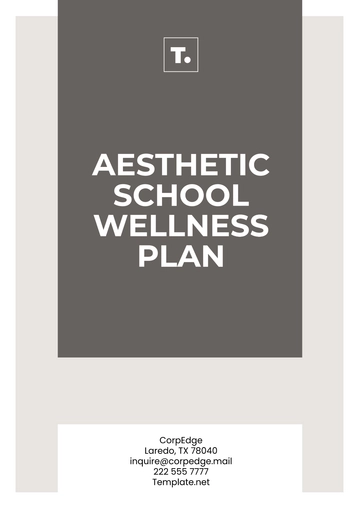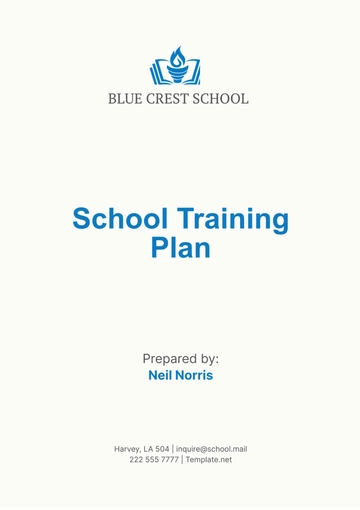Free Aesthetic School Wellness Plan

Prepared by: [Your Name]
Company: [Your Company Name]
Date: [Insert Date]
I. Introduction
The wellness of students in an aesthetic school setting is crucial for fostering creativity, emotional well-being, and personal growth. This Aesthetic School Wellness Plan is designed to integrate physical, mental, emotional, and social well-being into the student experience. By providing a balanced approach to health, this plan aims to support students in developing their artistic talents while maintaining their overall well-being.
II. Vision and Goals
Vision:
To cultivate a vibrant, inclusive, and supportive environment where students can thrive creatively, emotionally, and physically, enabling them to reach their full artistic potential while nurturing their overall wellness.
Goals:
Promote Physical Well-being: Encourage healthy lifestyle choices and practices that enhance physical health and energy levels.
Foster Mental Health Awareness: Provide resources and strategies for managing stress, anxiety, and the mental challenges that come with an artistic career.
Support Emotional Wellness: Help students develop emotional resilience, empathy, and self-awareness.
Enhance Social Connections: Create opportunities for students to build a strong sense of community, belonging, and collaboration.
Cultivate Academic Success: Offer tools and strategies to help students balance artistic development with academic responsibilities.
III. Key Areas of Focus and Strategies
A. Physical Wellness
Strategies:
Movement and Stretching Classes: Offer regular yoga, Pilates, and stretching classes to improve flexibility, reduce stress, and prevent injuries from prolonged sitting or repetitive movements.
Healthy Eating Initiatives: Provide nutritious snacks in common areas, including fruits, nuts, and other wholesome options to support physical energy levels.
Hydration Stations: Ensure easily accessible water stations to encourage proper hydration throughout the school day.
Physical Activity Breaks: Encourage short breaks between long studio or class sessions to promote movement and prevent burnout.
Ergonomic Support: Provide ergonomic furniture and setup guidance in classrooms and studio spaces to minimize physical strain.
B. Mental Wellness
Strategies:
Mindfulness and Meditation Sessions: Offer weekly mindfulness meditation sessions to help students focus, reduce anxiety, and improve mental clarity.
Creative Journaling Workshops: Encourage students to engage in journaling as a therapeutic tool to manage stress, express feelings, and boost creativity.
Stress Management Workshops: Provide workshops on stress reduction techniques such as deep breathing exercises, time management, and setting healthy boundaries.
Mental Health Resources: Offer access to counseling services and mental health professionals who can support students with managing academic or creative pressure.
Creative Breaks: Schedule structured creative "time-off" sessions where students can engage in spontaneous, stress-free artistic activities to refresh their minds.
C. Emotional Wellness
Strategies:
Emotional Resilience Workshops: Provide workshops focused on building emotional resilience, handling failure, and embracing vulnerability in the creative process.
Peer Support Networks: Establish peer mentorship and support groups where students can share experiences, challenges, and strategies for emotional growth.
Art Therapy Sessions: Offer art therapy opportunities where students can explore and express their emotions through various forms of art in a safe and guided environment.
Celebration of Achievements: Regularly recognize and celebrate students' artistic achievements and milestones, big and small, to foster a sense of pride and motivation.
Access to Guidance: Offer faculty and staff availability for students to discuss personal and emotional challenges in a supportive, non-judgmental environment.
D. Social Wellness
Strategies:
Community-Building Events: Host regular social events, including gallery exhibitions, art talks, group projects, and field trips to strengthen the school’s community and provide opportunities for collaboration.
Collaborative Projects: Encourage team-based art projects, performances, or exhibitions to foster cooperation, communication, and creative sharing among students.
Student Clubs and Organizations: Support the creation of student-led clubs, such as art collectives or creative writing groups, to allow students to connect over shared artistic interests.
Cultural Awareness Initiatives: Organize cultural exchange events and activities that allow students to explore diverse artistic traditions and foster inclusivity and respect.
Counseling and Support Services: Provide students with easy access to emotional and social support, whether through on-campus counseling or peer support initiatives.
E. Academic and Artistic Wellness
Strategies:
Time Management Workshops: Offer training on how to balance academic work with artistic development and personal life.
Creative Mentorship Programs: Pair students with mentors from various artistic disciplines to guide their professional and personal growth.
Artist Talks and Masterclasses: Provide opportunities for students to attend workshops, talks, and masterclasses with professional artists to expand their creative knowledge and gain real-world insight.
Studio Time Management: Encourage effective time management for students working on large art projects, providing them with the skills to organize their studio and artistic work.
Stress-Free Assessments: Implement holistic and supportive assessment methods that focus on growth and improvement rather than stress-inducing tests.
IV. Implementation Plan
A. Roles and Responsibilities:
Wellness Committee: Oversee the development and implementation of wellness initiatives, monitor progress, and gather student feedback.
School Leadership: Ensure that wellness programs are integrated into the school’s culture and provide ongoing resources and support.
Faculty and Staff: Support wellness initiatives by creating a positive and encouraging environment within their classrooms and studios.
Students: Participate in wellness programs, provide feedback, and promote a positive and supportive culture.
B. Timeline:
Phase 1 (Month 1-3): Conduct wellness needs assessment and introduce foundational wellness programs (mental health resources, physical wellness classes, etc.).
Phase 2 (Month 4-6): Launch community-building activities, introduce stress management workshops, and increase access to emotional wellness support.
Phase 3 (Month 7-12): Evaluate program effectiveness, gather student feedback, and expand wellness initiatives to further enhance physical, emotional, and social well-being.
V. Measurement and Evaluation
Key Performance Indicators (KPIs):
Program Participation: Monitor student engagement in wellness activities, including classes, workshops, and support groups.
Student Feedback: Gather regular feedback through surveys and focus groups to assess satisfaction and areas for improvement.
Wellness Metrics: Track improvements in mental health, emotional resilience, physical activity, and academic performance through surveys and interviews.
Retention and Engagement: Measure student retention rates and their involvement in extracurricular or wellness activities.
Evaluation Methods:
Surveys and Focus Groups: Collect quantitative and qualitative data through surveys and student interviews to assess the impact of wellness initiatives.
Regular Reporting: Provide an annual wellness report summarizing outcomes, identifying areas for growth, and making recommendations for future programming.
VI. Sustainability Plan
Ongoing Support and Funding: Secure ongoing funding for wellness initiatives through partnerships, sponsorships, and student fees.
Student Leadership: Foster a culture of student leadership by encouraging students to take ownership of wellness programs and initiatives.
Collaboration with External Experts: Work with wellness professionals, therapists, and community organizations to enhance the quality of wellness programming.
Continuous Evaluation and Adaptation: Continuously evaluate and adapt wellness strategies to reflect the changing needs and interests of the student body.
VII. Conclusion
The Aesthetic School Wellness Plan aims to create a supportive and empowering environment where students can thrive creatively, emotionally, and physically. By focusing on comprehensive wellness, this plan supports students in developing their artistic talents while ensuring they maintain their overall well-being. Through consistent implementation, evaluation, and student involvement, this plan will create a thriving school culture where creativity and wellness go hand in hand.
- 100% Customizable, free editor
- Access 1 Million+ Templates, photo’s & graphics
- Download or share as a template
- Click and replace photos, graphics, text, backgrounds
- Resize, crop, AI write & more
- Access advanced editor
You may also like
- Finance Plan
- Construction Plan
- Sales Plan
- Development Plan
- Career Plan
- Budget Plan
- HR Plan
- Education Plan
- Transition Plan
- Work Plan
- Training Plan
- Communication Plan
- Operation Plan
- Health And Safety Plan
- Strategy Plan
- Professional Development Plan
- Advertising Plan
- Risk Management Plan
- Restaurant Plan
- School Plan
- Nursing Home Patient Care Plan
- Nursing Care Plan
- Plan Event
- Startup Plan
- Social Media Plan
- Staffing Plan
- Annual Plan
- Content Plan
- Payment Plan
- Implementation Plan
- Hotel Plan
- Workout Plan
- Accounting Plan
- Campaign Plan
- Essay Plan
- 30 60 90 Day Plan
- Research Plan
- Recruitment Plan
- 90 Day Plan
- Quarterly Plan
- Emergency Plan
- 5 Year Plan
- Gym Plan
- Personal Plan
- IT and Software Plan
- Treatment Plan
- Real Estate Plan
- Law Firm Plan
- Healthcare Plan
- Improvement Plan
- Media Plan
- 5 Year Business Plan
- Learning Plan
- Marketing Campaign Plan
- Travel Agency Plan
- Cleaning Services Plan
- Interior Design Plan
- Performance Plan
- PR Plan
- Birth Plan
- Life Plan
- SEO Plan
- Disaster Recovery Plan
- Continuity Plan
- Launch Plan
- Legal Plan
- Behavior Plan
- Performance Improvement Plan
- Salon Plan
- Security Plan
- Security Management Plan
- Employee Development Plan
- Quality Plan
- Service Improvement Plan
- Growth Plan
- Incident Response Plan
- Basketball Plan
- Emergency Action Plan
- Product Launch Plan
- Spa Plan
- Employee Training Plan
- Data Analysis Plan
- Employee Action Plan
- Territory Plan
- Audit Plan
- Classroom Plan
- Activity Plan
- Parenting Plan
- Care Plan
- Project Execution Plan
- Exercise Plan
- Internship Plan
- Software Development Plan
- Continuous Improvement Plan
- Leave Plan
- 90 Day Sales Plan
- Advertising Agency Plan
- Employee Transition Plan
- Smart Action Plan
- Workplace Safety Plan
- Behavior Change Plan
- Contingency Plan
- Continuity of Operations Plan
- Health Plan
- Quality Control Plan
- Self Plan
- Sports Development Plan
- Change Management Plan
- Ecommerce Plan
- Personal Financial Plan
- Process Improvement Plan
- 30-60-90 Day Sales Plan
- Crisis Management Plan
- Engagement Plan
- Execution Plan
- Pandemic Plan
- Quality Assurance Plan
- Service Continuity Plan
- Agile Project Plan
- Fundraising Plan
- Job Transition Plan
- Asset Maintenance Plan
- Maintenance Plan
- Software Test Plan
- Staff Training and Development Plan
- 3 Year Plan
- Brand Activation Plan
- Release Plan
- Resource Plan
- Risk Mitigation Plan
- Teacher Plan
- 30 60 90 Day Plan for New Manager
- Food Safety Plan
- Food Truck Plan
- Hiring Plan
- Quality Management Plan
- Wellness Plan
- Behavior Intervention Plan
- Bonus Plan
- Investment Plan
- Maternity Leave Plan
- Pandemic Response Plan
- Succession Planning
- Coaching Plan
- Configuration Management Plan
- Remote Work Plan
- Self Care Plan
- Teaching Plan
- 100-Day Plan
- HACCP Plan
- Student Plan
- Sustainability Plan
- 30 60 90 Day Plan for Interview
- Access Plan
- Site Specific Safety Plan





























